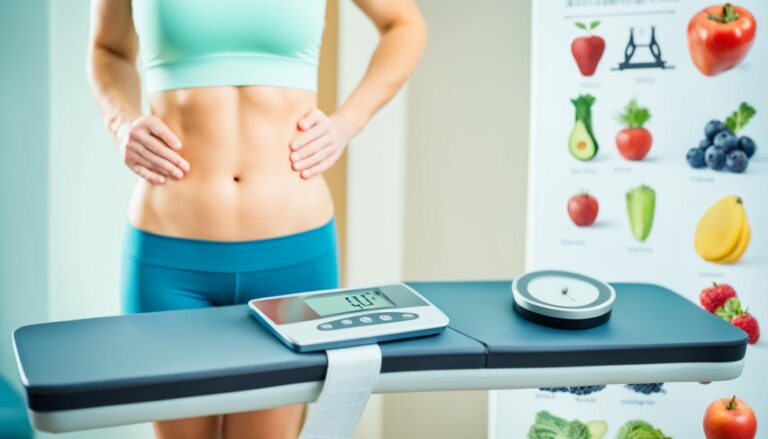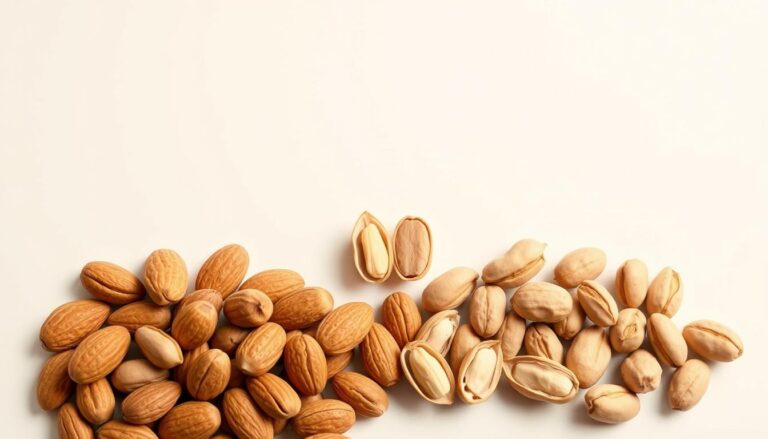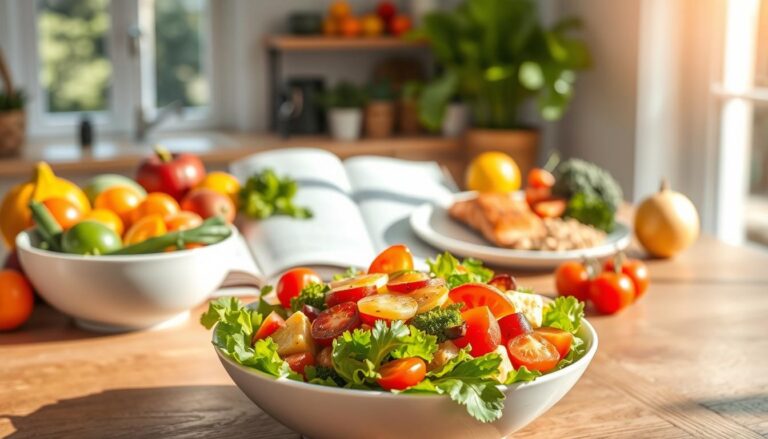Living with diabetes doesn’t mean you have to give up flavor and fun. There are many foods that people with diabetes can eat without worrying about their blood sugar. By knowing what foods are good for you, diabetics can eat well and keep their blood sugar in check. This article will show you the best foods for diabetics, including veggies, fruits, grains, and proteins. With the right info and a bit of creativity, diabetics can enjoy tasty, worry-free meals and snacks.
Key Takeaways
- Diabetes doesn’t have to mean sacrificing delicious food options.
- Understanding “free” foods can help diabetics maintain a balanced, healthy diet.
- Exploring the nutritional benefits of various food groups is key to making informed choices.
- With the right knowledge, diabetics can enjoy flavorful, guilt-free meals and snacks.
- A well-rounded approach to diet and lifestyle can support optimal blood sugar control.
Understanding Free Foods for Diabetics
Dealing with diabetes can be tough, but knowing about “free foods” helps. These are foods or drinks with under 20 calories or less than 5 grams of carbs per serving. They don’t need to be counted in the exchange system, making them good for managing blood sugar.
What Are Free Foods?
The American Diabetes Association and the Academy of Nutrition and Dietetics say free foods for diabetics include:
- Carbonated water
- Unsweetened cocoa powder
- Coffee or tea
- Raw cabbage
- Sugar-free candy
- Raw cucumber
- Whipped topping
- Raw salad greens
- Sugar-free gum
It’s key to limit these free foods to three a day and spread them out. This helps avoid sudden spikes in blood sugar.
| Nutrient | Recommended Limit for Diabetics |
|---|---|
| Saturated Fat | Less than 7% to 10% of Daily Value |
| Sodium | Less than 7% to 10% of Daily Value |
| Added Sugars | Less than 7% to 10% of Daily Value |
By knowing about free foods, people with diabetes can enjoy a variety of foods. This helps keep their blood sugar healthy.

Vegetables: Nature’s Guilt-Free Delights
For diabetics, vegetables are a true treasure trove of nutritional bounty. They are packed with vitamins, minerals, and fiber. These non-starchy vegetables are key to a balanced, diabetes-friendly diet. The American Diabetes Association suggests eating low-carb vegetables that are full of antioxidants. These veggies have a low effect on blood sugar levels.
Some top fiber-rich vegetables for diabetics include spinach, kale, bell peppers, carrots, broccoli, cauliflower, Brussels sprouts, asparagus, celery, onions, tomatoes, zucchini, garlic, mushrooms, and leafy greens. These veggies are nutrient-dense and can be eaten freely. They provide essential nutrients without the carbs found in other foods.
| Vegetable | Carbohydrates (per 1 cup) | Fiber (per 1 cup) | Vitamins and Minerals |
|---|---|---|---|
| Spinach | 6.9 g | 4.3 g | Vitamins A, C, K, Folate, Manganese |
| Broccoli | 6 g | 2.4 g | Vitamins C, K, Folate, Chromium |
| Cauliflower | 5.3 g | 3 g | Vitamins C, K, Folate, Sulfur Compounds |
| Tomatoes | 4.8 g | 1.2 g | Vitamins C, K, Potassium, Lycopene |
By embracing the vibrant array of non-starchy vegetables, diabetics can enjoy nature’s most nutritious offerings. These veggies fuel the body with essential vitamins, minerals, and fiber. They help keep blood sugar levels in check.

Fruits: Sweet Treats with Benefits
Fruits are great for people with diabetes. They can be a sweet treat and are full of important nutrients. The American Diabetes Association says to pick low-glycemic fruits to avoid big spikes in blood sugar.
Some top diabetic-friendly fruits are apples, bananas, lemons, limes, plums, apricots, peaches, strawberries, blueberries, and oranges. These nutrient-rich fruits are full of fiber, vitamins, and minerals. Frozen fruits are also good because they’re picked when ripe and keep their good stuff.
The fiber in fruits helps control blood sugar by slowing down sugar absorption. This makes them a great choice for diabetics. Adding a mix of low-glycemic fruits to meals and snacks can be tasty and good for health.
“Fruits can be a great choice for diabetics, as they provide a natural source of sweetness along with valuable nutrients and fiber.”
Fruits can be eaten fresh, frozen, or used in desserts. They’re a key part of a diet for diabetics. By choosing wisely and eating them with other healthy foods, people with diabetes can enjoy sweetness without worrying about their blood sugar.
Beans and Legumes: Protein-Packed Powerhouses
For diabetics, beans and legumes are superfoods. They are full of fiber, plant-based protein, and complex carbs. These slow-digesting foods help keep blood sugar levels stable. The American Diabetes Association suggests adding beans and legumes like black beans and kidney beans to your diet.
Cooking legumes in an instant pot or slow cooker makes them easier to digest and use in meals. They are a budget-friendly and versatile protein source for diabetics. A 2020 review in Nutrients found that beans can lower blood glucose and A1c levels in people with diabetes.
- Beans and lentils are high in fiber, which slows the absorption of carbohydrates and helps regulate blood sugar levels.
- Legumes are a great source of plant-based protein, making them an excellent choice for diabetics who need to manage their protein intake.
- According to a study published in the International Journal of Food Science, including 3-6 grams of cinnamon a day in the diet can lead to lower blood glucose levels.
Adding different beans and legumes to your meals is easy and tasty. You can make a bean chili, roast chickpeas, or add lentils to your salad. These protein-rich foods are a must for every diabetic’s kitchen.

“Eating a diet rich in beans and legumes can help manage diabetes by stabilizing blood sugar levels and providing essential nutrients.”
– American Diabetes Association
What foods can diabetics eat freely?
Whole Grains: Fiber-Rich Fuel
Whole grains are great for diabetics. They are full of fiber, which slows down the digestion of carbs and prevents blood sugar spikes. The American Diabetes Association suggests choosing brown rice, quinoa, barley, and 100% whole wheat bread over refined grains.
Whole grains are packed with benefits for diabetics. They are low-glycemic, meaning they don’t cause sudden spikes in blood sugar. The fiber in whole grains also helps you feel full, which can help with weight control. Adding different whole grains for diabetes to your meals can help keep your blood sugar stable and improve your health.
It’s important to watch how much whole grain you eat. Even healthy carbs can affect your blood sugar levels. By choosing whole wheat bread, brown rice, and quinoa, diabetics can enjoy complex carbs without the negative effects of refined grains.
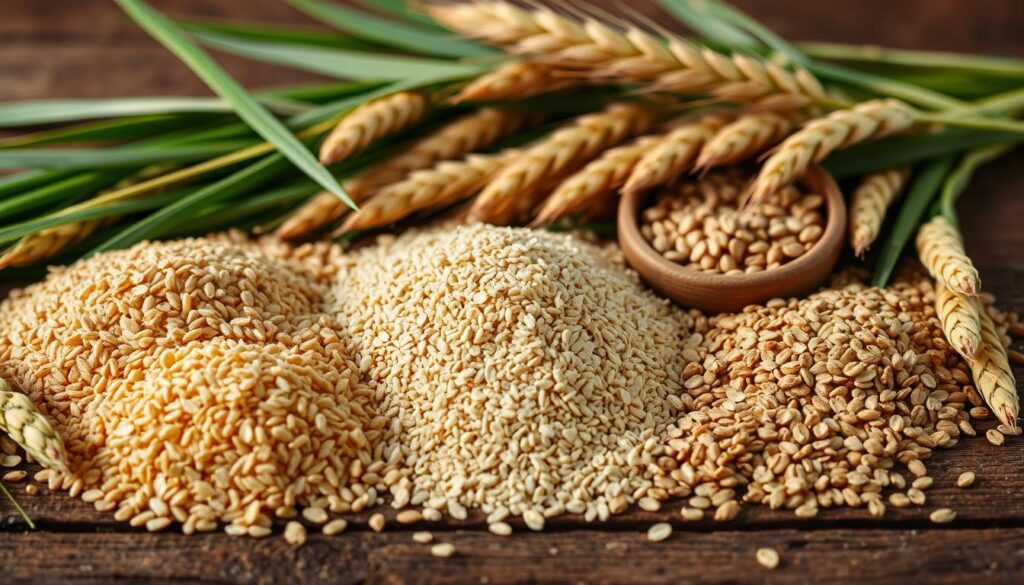
“Whole grains are a diabetic’s best friend – they provide sustained energy, keep blood sugar stable, and satisfy cravings without the guilt.”
Dairy Delights: Calcium and Protein
Dairy products are great for diabetics, offering calcium and protein. The American Diabetes Association suggests choosing low-fat or fat-free options like plain yogurt, cottage cheese, and some cheeses. This helps keep saturated fat intake low.
Diabetics should avoid sweetened dairy products. Instead, pick unsweetened, plain ones. Then, add fresh fruit or a bit of a low-calorie sweetener for taste.
Adding dairy to meals and snacks is good for nutrition and blood sugar control. Try to have about 3 dairy servings a day. A serving is like 200ml of milk, a pot of yogurt (125g-150g), or 30g of paneer cheese.
| Dairy Product | Portion Size | Carbohydrates | Protein | Fat |
|---|---|---|---|---|
| Plain Yogurt | 1 cup (240ml) | 12g | 12g | 4g |
| Cottage Cheese | 1/2 cup (100g) | 5g | 14g | 2g |
| Cheddar Cheese | 1 oz (28g) | 0g | 7g | 9g |
By adding plain yogurt, cottage cheese, and cheese to their diet, diabetics can get the good stuff from calcium and protein. This helps with blood sugar control.
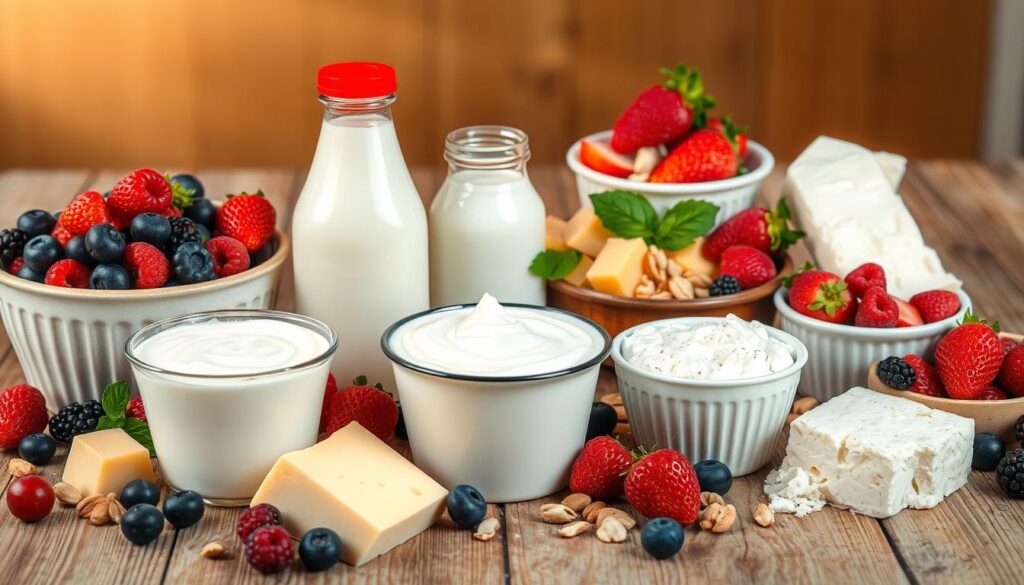
“Dairy products can be a valuable part of a diabetic’s diet, as they provide essential nutrients like calcium and protein.”
Lean Protein: Building Blocks for Health
Protein is key for diabetics because it slows down carbs and keeps blood sugar stable. The American Diabetes Association suggests eating lean protein sources. These include seafood, poultry, and some red meat. Good examples are eggs, fish like salmon and tuna, chicken, turkey, beef tenderloin, and pork loin. Plant-based protein options like beans, lentils, and tofu are great too. They offer fiber and other good stuff.
It’s important for diabetics to cook proteins in healthy ways like baking, grilling, or sautéing. Avoid adding too much fat, sauces, and breading. Mixing lean proteins, healthy fats, and fiber-rich carbs in meals helps keep blood sugar stable and supports health.
- Lean proteins like chicken give more nutrients per serving than high sodium or fat ones.
- Plant-based proteins like tofu and quinoa are great protein-rich choices.
- Frozen and canned meats and fish offer low-sodium protein options.
“Eating the right amount of protein can aid in blood sugar balance, diabetes management, increased energy, strength, muscle growth, and increased satiety.”
By choosing leanprotein sources wisely, diabetics can enjoy the benefits of this important nutrient while managing their blood sugar.
Condiments and Flavorings: Spice Up Your Life
Living with diabetes doesn’t mean you have to give up flavor. There’s a wide range of sugar-free condiments and low-calorie flavorings that can make your meals exciting. You can use tangy vinegar, fragrant olive oil, strong mustard, and aromatic spices and herbs.
The American Diabetes Association says these options can make your food more interesting without adding carbs. When you’re shopping, check the labels. Pick condiments and flavorings that don’t have added sugars or many carbs.
Adding Zest Without Sugar
Instead of sugary ketchup, use a zero-sugar-added version. It usually has about 1 gram of carbs per tablespoon. Mustard is also great, with only 0.6 to 0 grams of carbs per serving. And don’t forget about herbs and spices like black pepper, garlic, cinnamon, ginger, and turmeric. They add flavor and might be good for your health.
By adding these sugar-free condiments and low-calorie flavorings to your cooking, you can make tasty meals that won’t raise your blood sugar. It’s all about finding tasty and healthy options to spice up your life, guilt-free.
“Healthy eating doesn’t have to be boring. With a little creativity, you can make your meals both delicious and diabetes-friendly.” – Registered Dietitian, XYZ Clinic
Guilt-Free Desserts: Indulge Mindfully
Having diabetes doesn’t mean you must skip sweet treats. With some planning and mindful eating, diabetics can enjoy desserts that are sugar-free, low in carbs, and made with fruit. This way, you won’t see your blood sugar go up.
The American Diabetes Association suggests trying sugar-free popsicles, 100% fruit popsicles, sugar-free gelatin, and pudding or ice cream sweetened with zero-calorie or low-calorie sweeteners for diabetes like stevia and erythritol. You can also make a fruit salad at home without sugar for a tasty and healthy dessert.
Remember, it’s important to watch how much you eat when it comes to desserts with diabetes. Adding these guilt-free options to your diet lets you enjoy sweets while keeping your health in check.
| Dessert Option | Carbohydrate Content | Nutritional Benefits |
|---|---|---|
| Sugar-Free Popsicles | 5-10g per serving | Low in calories, no added sugars |
| 100% Fruit Popsicles | 10-15g per serving | Provides natural sweetness and fruit-based nutrients |
| Sugar-Free Gelatin | 2-5g per serving | Low in calories, high in protein |
| Pudding/Ice Cream with Zero-Calorie Sweeteners | 10-20g per serving | Satisfies sweet cravings without added sugars |
| Homemade Fruit Salad | 15-20g per serving | Provides natural sweetness and essential nutrients |
To enjoy desserts with diabetes, always control your portion size and pick low-carb, sugar-free options. With creativity and care, you can fulfill your sweet cravings without harming your health.
“Indulging in desserts can be a joyful experience, even for those with diabetes. The key is finding the right balance and making mindful choices that don’t compromise your health.”
Beverages: Quenching Your Thirst
Staying hydrated is key for everyone, including those with diabetes. Water is top choice because it has no calories or carbs. Other good options include unsweetened coffee, tea, and sparkling water.
Milk and plant-based milks can also be good for diabetics, but watch the carbs. The American Diabetes Association warns against sugary drinks like soda, sports drinks, and some fruit juices. These can cause quick spikes in blood sugar.
By choosing wisely, diabetics can stay hydrated and support their health. Here are some important tips:
- Ready-made low-fat chocolate milk has 70 calories, 16 grams of carbs, and 2 grams of fat per cup.
- A 16-ounce fast-food iced tea can have up to 36 grams of carbs.
- Orange juice contains 26 grams of carbs in one cup.
- A typical coffeehouse chai latte has 33 grams of carbs, while a homemade version has less than 1 gram of carbs.
| Beverage | Carbs (per serving) | Calories (per serving) |
|---|---|---|
| Lemonade (16 oz) | 60 grams | N/A |
| Hot Chocolate (medium) | 60 grams | N/A |
| Apple Cider/Juice (1 cup) | 26 grams | N/A |
| Mango Smoothie (12 oz) | 58.5 grams | N/A |
| Ginger Ale (20 oz) | 60 grams | N/A |
| Mocha (coffeehouse) | 40 grams | 300+ calories |
| Soda (1 can) | 40 grams | 150 calories |
By choosing wisely and avoiding high-sugar drinks, diabetics can stay hydrated and keep their blood sugar stable. Focusing on water, unsweetened beverages, milk, and plant-based milks helps maintain healthy blood sugar levels and overall health.
Conclusion
Keeping a diabetic-friendly diet is key to managing diabetes and staying healthy. It’s about choosing foods like veggies, fruits, whole grains, lean proteins, and healthy fats. The American Diabetes Association offers great advice on what foods are best for managing diabetes with diet.
With some planning and creativity, people with diabetes can enjoy tasty, guilt-free meals and snacks. Eating whole, less processed foods and watching portion sizes helps control blood sugar. Talking to a registered dietitian can help make a balanced meals for diabetes plan that fits your needs.
A diabetic-friendly diet that focuses on nutrient-rich foods and portion control is powerful. It helps manage diabetes and leads to a healthier life. By following the “free foods” idea and making smart choices, people with diabetes can eat a variety of tasty, healthy foods.

